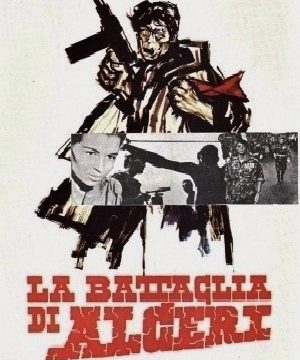One of the best things about watching a number of older foreign motion pictures is that many of these titles offer me the chance to explore aspects of other countries histories that I have only heard about passing or never even knew existed, Jean Renoir’s The Rules Of The Game was a good example of this, a 1939 motion picture that clued me in on the societal issues of that day and age in France. The subject of this movie review, the 1966 film The Battle Of Algiers, is another strong example of this phenomenon, centering itself on an eight year long North Africa conflict that I had no idea even transpired.
The Algerian War was a conflict centered in North Africa that was at first concentrated against the Fourth French Republic before segueing into being a war with France itself. Fighting against the French government in charge of Algeria at the time was the resistance movement the National Liberation Movement (referred throughout the movie as the FLN), which moved into the realm of guerrilla warfare in order to take down the government. What ensued from their efforts of rebellion was an eighty year long war that resulted in much bloodshed, with the FLN refusing to go down without a fight.
There’s an appropriately sprawling nature to the way The Battle Of Algiers tells its tale of political upheaval, with the films fascinating decision to eschew giving the story a concrete protagonist being perhaps the most noteworthy way to exemplify the sheer magnitude of the real-life events occurring on-screen. Oh, there are plenty of recurring individuals that pop up on-screen throughout the movie, but there really isn’t a “main character” per se contained within the war-filled story, with the only person in this story coming closest to fulfilling that specific role being FLN fighter Petit Omar (Mohamed Ben Kassen).
Not only does The Battle Of Algiers function perfectly fine on a surface level without a main character to guide its story, it’s actually a brilliant move from an analytic perspective, since it means the plot is not in service of one particular lead character but rather is at the whims of the real events being recreated. The real life Algerian War was bigger than any one single human being, why should the movie be any different? Letting the war itself, and the effects it had on the various citizens fighting in this cause, be the primary focus of The Battle Of Algiers is a phenomenal concept that shows how screenwriters Gino Pontecorvo and Franco Solinas are looking to examine this extended combat situation in a more in-depth fashion.
You can also get that impression from how the movie breaks apart from many modern-day war movies that depict wartime combat as simply “SO KEWL AND AWESOME BRO!!!”. Here, the way more intense sequences are visually depicted really allows one to soak in the terror and horrors of war. This is especially true in the various bombing sequences, such as one executed by the government itself and three others done by female FLN fighters, which are harrowing in the manner in which they filmed. The gravity of losing human life is felt in the way the camera lingers over the broken buildings, the bodies lying limp on the ground and the hysterical masses reacting to the carnage that has been wrought. These heinous acts are not an opportunity for exploitation in the eyes of The Battle Of Algiers, rather, they’re seen as a chance for the audience to see the darkest hours of this conflict in an unflinching style.
All of those intense sequences are usually accompanied by a magnificent score by Ennio Morricone and the writer/director of this motion picture, Gillo Pontecorvo. The pieces of music this duo conjure up add a lot to the unique atmosphere The Battle Of Algiers creates, a distinctive aura that was already gonna be pretty stirring due to the visuals depicted on-screen. The Battle Of Algiers was an educational experience for me as someone who was unfamiliar with this particular battle beforehand, but it’s also a fantastic cinematic experience in its own right, one that serves as an engrossing depiction of the hardships and cost of war and resistance.

